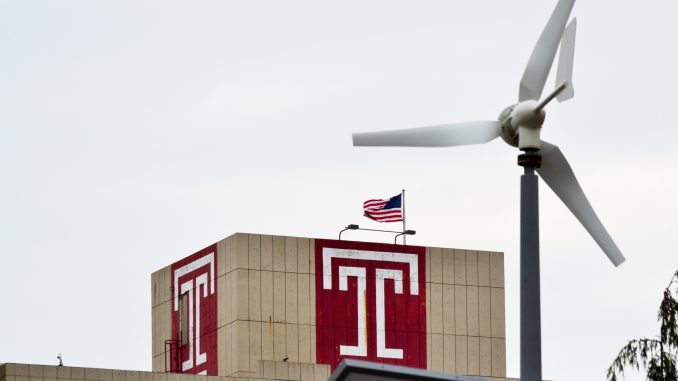
Morgan Hall is the new kid on the block in terms of on-campus housing.
Since its development, students have noticed there has been a notable uptick in wind activity surrounding the building, as well as on Cecil B. Moore Avenue.
Physics department chair Rongjia Tao said because of Morgan Hall’s size – 660,000 square feet and 27 stories tall – it blocks the nearby winds and creates canyon-like effects, pushing the wind downward toward the sidewalk on the street level, which causes pedestrians to feel a more intense wind. This is a phenomenon commonly known as the wind tunnel effect.
“The wind speed in the tunnel will be much higher than the normal wind speed,” Tao said. “In addition, it also often creates vortex-turbulence inside the tunnel near the ground and near the building wall. Therefore, on a windy day, not only facing high-speed wind at the street tunnel, one may also see some leaves of dirt quickly rotate.”
Grounds Department Superintendent Glenn Eck said there are other areas on Main Campus where the wind tunnel effect can be observed, such as on Montgomery Avenue between Klein and Conwell halls and between Anderson Hall and the TECH Center.
“The only way it really affects [grounds keeping is] that it can be a little harder to establish plants under those conditions,” Eck said.
Eck said years ago there used to be trees along the street between Klein and Conwell halls. Apart from that area being tight and not particularly sunny, the trees were hard to maintain because the wind tunnel effect pulls the moisture out of the soil.
“We were never able to get trees established there in that particular spot,” Eck said.
There is no landscaping near the outside of Morgan Hall – the landscaping and grassy area resides within the two towers as part of Morgan’s 30,000 square-foot terrace for the residents.
“When you put landscaping in front of the building, you’re trying to sort of soften the building and make it blend into the landscape, but it doesn’t really work on a tower that tall,” Eck said.
With the powerful winds surrounding these buildings, snowfall and ice can be blown around on roofs, as well as blown off the side of the buildings. During the winter, police cornered off certain areas to avoid blow-off onto Cecil B. Moore Avenue. Facilities employees also worked to manage the snow on top of buildings like Morgan Hall to avoid injuries.
Standing in the courtyard between Morgan Hall north and south with the wind visibly blowing their shirts, junior Perry Bachstein and sophomore Ahmed Amir said they think the wind makes walking to class even worse when the weather is bad.
“When it’s cold, it makes it 10 times colder,” Amir said. “If someone is walking next to you can’t talk, you have to yell.”
“I’ve gotten very close to wearing a scarf one day, but I luckily haven’t crossed that line,” Bachstein said.
Freshman Gabrielle Flanagan said the wind tunnels are so bad, it sometimes makes her unbalanced.
“I’m not a huge fan of it,” Flanagan said.
In an extreme case, the wind tunnel effect was reported to have been the cause of 25 incidents and injuries including internal bleeding, as well as one death in Europe, according to the BBC.
The extremely strong winds surrounding Bridgewater Place in Leeds, England crushed the victim in 2011. These winds also caused a buggy to be blown over, containing a three-month-old infant.
Logan Beck can be reached at logan.beck@temple.edu.


Be the first to comment